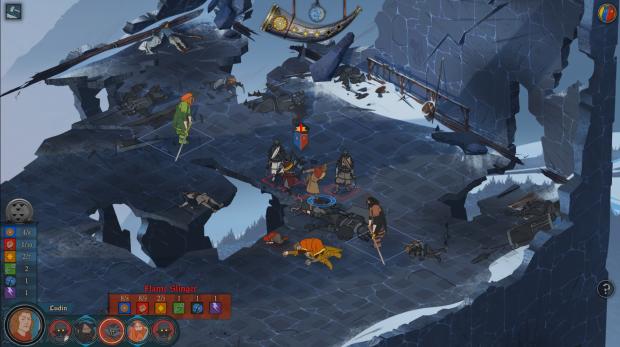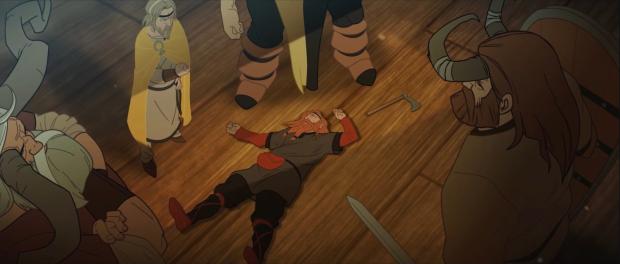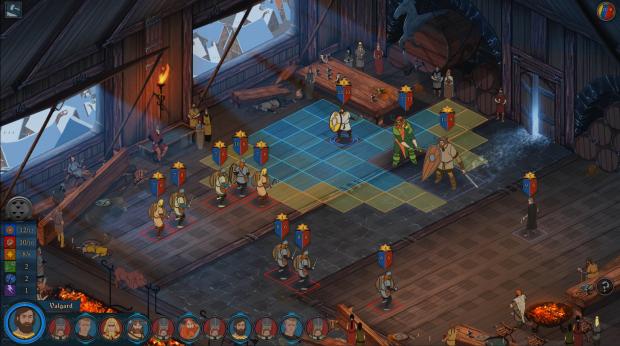The Banner Saga Review
A man approaches your caravan. As he reaches you, he raises his arms and asks to be taken as your prisoner. You have four choices: ask him to join your caravan, bind his arms and take him prisoner, leave him behind, or murder him.
The Banner Saga is built on such decisions, and none of them are easy. If he joins your caravan he will take up supplies, whether a prisoner or free. Alive he may sow discontent against you, having attempted to kill you several days before. Abandoning him is a death sentence, unless he somehow breaks free, in which case he will no doubt hunt you down. But with the caravan looking up to you for leadership, striking down an unarmed man may send morale plummeting.
This is the best trick The Banner Saga pulls: leaving you not entirely sure of the consequences of your actions before you make them; I took the man prisoner, with no idea what would happen. Everything exists in a grey area, with potential to both help and hinder you, completely opposed to the Mass Effect-style “good and evil” option. Allowing every refugee you meet to join you may seem like the best idea, but with supplies down to a day or two as it is, they will only be more mouths to feed.

Several character perspectives tell the tale of a darkness descending from the North, driving evil forces before it into the land of man and Varl, a race of horned giants. It’s incredibly refreshing to have a fantasy world not made up of orcs, elves and dwarfs, with the evil race in the game called the Dredge, created by a god jealous of other gods’ creations.
The Viking saga narrative is told through beautiful still image cut scenes, mostly with text, though occasionally with a voice over. You take the role of a caravan leader, at first a Varl tithe-collector, and later a human hunter named Rook who is leading his refugee train from one town to the next. The direction of travel is linear, despite a rich and detailed world map, but how the story progresses is otherwise entirely up to you.
Travel between towns takes place against scrolling still images, the quality of which outdoes the cut scenes. On the journey, events occur that determine where the story goes, much like my opening example. How many of these are set pieces, and how many are random or depend on previous actions I’m unsure, but it never feels like they are out of place in the world.

The mechanics of travel, beyond the events that pop up, are fairly simple. Three kinds of traveller make up your caravan: Clansmen (being regular people), Fighters and Varl. Making sure you have enough supplies to reach the next village is the most pressing concern, but you must also rest at camp to increase morale and heal wounded warriors, which means journeys take longer.
Morale ties into the two kinds of combat, the meatiest of which is the turn-based strategy. This makes up the bulk of the combat, whether the encounter is on the road or a siege of one of the towns/cities. You choose up to six characters to enter into each battle, a mixture of humans and Varl, from a changing pool of named characters. Who is available will depend on your choices in the rest of the game; it is entirely possible to kill your best warrior by picking the wrong option during a random event.
The combat itself involves using each character in turn, alternating between you and your opponent. Movement comes first, then the use of abilities, whether it be a basic attack, one that does AoE damage, or magic. It’s surprisingly deep, with several classes for characters to fall into: for example, a Varl that has high armour but low strength can take extreme punishment, but will rely on the archers behind him to damage the enemy.

Several stats govern how effective a character is at what. In a neat move, strength serves as both health and attack power, meaning damage reduces a character’s use in battle. Damage is negated by armour, a simple sum of strength – opponents armour = damage, to the point of attacks being deflected. It makes targeting armour important, as chipping it away will mean the final blow will fall quicker, but leaves the opponent able to deal more damage to you. How much armour damage is done depends on a character’s shield break score.
Willpower allows the use of abilities as well as extra movement and boosting attack power, but is governed by Exertion, which limits how much may be used at a time. Willpower is also influenced by morale, raising or lowering how much your characters start with. Luckily, despite the permadeath caused by world events, if a character dies in combat they are wounded, with lower combat stats in future until they rest in camp.
The other side of the combat is the war aspect, where your fighters and Varl from the caravan are pitched against a large force of the enemy. It boils down to making one of five decisions, be it leading yourself (which launches a turn based battle), choosing to form a battle line or retreat. The wording of the battle description is supposed to help you choose what to do, the aim being to lose as few lives as possible, but it’s mostly guesswork.
Naturally, characters can level up. The threshold for each level is determined by how many kills each character has racked up, which can lead to some imbalance in your team if you have particularly low damaging units. To actually upgrade, you need to spend a currency called Renown. It’s earned through battle and from making decisions elsewhere in the game.
Unfortunately, it is also the source of my one true gripe with The Banner Saga. The idea of one currency for all transactions is great, but in practice it becomes incredibly difficult to balance getting enough supplies to survive while also levelling up characters and purchasing items for them. It left me in a position at the end of the game where I couldn’t defeat the final boss on normal difficulty, as my team just weren’t experienced enough, yet I had no Renown left to level them with.
In fact none of them were the highest level, my caravan had half-starved in the final third of the journey and I hadn’t been purchasing items. It makes sense to limit the currency available, but the balance for me is just a little off. A little imbalance can be forgiven, though; it truly is an excellent game. I’ve mentioned how beautiful it looks, and the screenshots don’t do it justice. The aesthetics are matched by the music and background noise, which together make it incredibly atmospheric.
VERDICT: The Banner Saga is one of the most original games you’ll play this year. That such a small team has managed to create a story that will be unique to every player is astonishing, and that the story actually makes you care even more so. Buy this game.

SUPERB. This is the mark of greatness, only awarded to games that engage us from start to finish. Titles that score 9/10 will have very few problems or negative issues, and will deliver high quality and value for money across all aspects of their design.
Review code provided by publisher.




